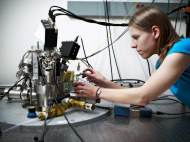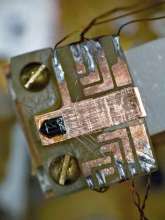Material with both magnetic and superconducting properties found
 Researchers at the Stanford University have made an interesting discovery after they sandwiched two nonmagnetic insulators together. Contrary to expectations, the layer where the two materials meet has both magnetic and superconducting regions – two properties which haven’t been found to co-exist in nature. The discovery could be a starting point for creation of new materials which could find various applications in technology.
Researchers at the Stanford University have made an interesting discovery after they sandwiched two nonmagnetic insulators together. Contrary to expectations, the layer where the two materials meet has both magnetic and superconducting regions – two properties which haven’t been found to co-exist in nature. The discovery could be a starting point for creation of new materials which could find various applications in technology.
Superconducting materials which are known thus far are capable to conduct electricity with no resistance and 100 percent efficiency, but they also expel any magnetic field that comes near them. However, experiments performed on a thin film of lanthanum aluminate which was laid onto a strontium titanate substrate led Julie Bert, a Stanford Institute for Materials and Energy Science (SIMES) graduate student, and her colleagues to a discovery that magnetic field can exist along superconductivity.
The structures were grown by researchers working with applied physicist Harold Hwang, who recently moved with his group from the University of Tokyo to join SIMES and now serves as deputy director. The atomic layer where the two oxides meet becomes metallic and allows current to flow with no resistance at temperatures close to absolute zero.
They used a used a scanning superconducting quantum interference device (SQUID) magnetometer to image the co-existing states on the scale of a few micrometers. The results showed that both superconductive and magnetic regions are inhomogeneous. The superconducting regions occupy only a small fraction of the measured areas while the magnetic regions have patches of micrometer-scale ferromagnetic regions.
Interestingly, researchers from the MIT performed an independent research where they used alternative means of measurement to prove the existence of magnetism between the same two materials.
Further investigation of the discovery should reveal whether the superconductivity and magnetism co-exist within the material while enhancing both properties, or whether they are fighting one another. The researchers are also starting experiments to see whether anything changes when the material is compressed, or when an electrical field is applied.
Aside better understanding of the phenomenon, the determination of the physical properties which occurs in these oxides could contribute to development of other materials which show potential to exhibit co-existence of superconductivity and magnetism.
“Modern technology gives us the amazing ability to grow materials atomic layer by atomic layer”, said Kathryn A. Moler, Stanford researcher who led the imaging studies. “The message of our work is that by doing so we can create new materials with surprising new properties.”
For more information, read the paper published in the Nature Physics named: “Direct imaging of the coexistence of ferromagnetism and superconductivity at the LaAlO3/SrTiO3 interface”.










Leave your response!